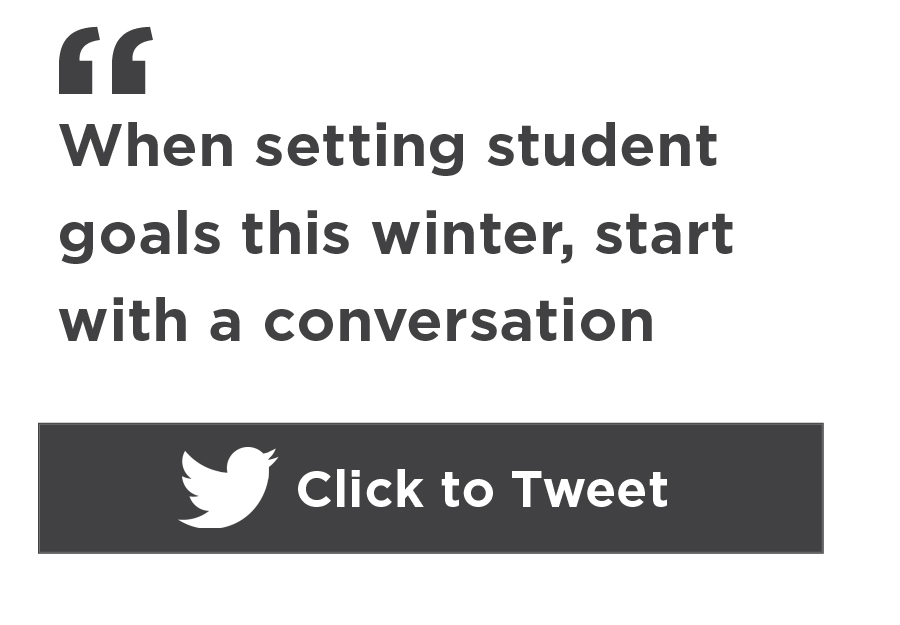
With every new year come New Year’s resolutions, and many people focus on getting in better shape. But even something as predictable as a spike in gym memberships at the start of the year is unlikely right now as COVID-19 continues to throw a wrench in things. Tried-and-true practices in your classroom—including goal setting with your students—could be disrupted, too, whether you’re setting goals for the first time this school year or revisiting fall goals.
Goal setting provides important benefits to students’ academic and social-emotional growth, and that’s not likely to change for students recovering from interrupted learning during COVID-19 school closures. In fact, it may be extra important because, as was true in the fall, goals can provide focus when things get chaotic.
The pandemic doesn’t have to derail your fitness goals, and there are ways to ensure goal setting with your class is a success this winter as well. Adapting to our still-challenging environment is less about changing the objective—setting motivating goals for students—and more about changing the approaches we take. Here are three ideas for how to set meaningful goals for students this winter.
1. Start with a conversation
The most important part of any teacher’s goal-setting practice is ensuring students set goals that are meaningful and realistic for them. You can’t set goals for students on your own—without understanding their aspirations, abilities, and motivations—and expect students to achieve them. They simply won’t be motivated that way. But when you put students in the driver’s seat, you play an essential role in guiding them toward focusing on learning that meets grade-level expectations and helps them catch up on essential missing content, as needed.
In talking with dozens of teachers about how they set goals with students, I’ve learned nothing is more important than one-on-one conversations with kids about what they hope to accomplish and why. As I note in my book, Step into Goal Setting: A Path to Growth, Motivation, and Agency, “One-on-one conversations are invitations to students to engage in co-constructing their goals with their teacher. In one-on-one conversations, teacher and student work together to understand how the student is learning, what the student’s next goal should be, and what the student should do in order to get to that goal. They leave the conversation having plotted or better understood together that student’s learning journey, with each of a student’s goals serving as another mile marker on the road.”
When you talk with your students, you can start by reflecting on all you were able to accomplish since the start of the year. Next, be sure to review evidence of their learning, talk about their aspirations, and set concrete goals and action steps. If your school tests with MAP® Growth™, include assessment data in the conversation. Our MAP Growth Goal Explorer can help you think about average, stretch, and custom goals to work on between test events.
2. Find new, independent activities to build and measure skills
Many of the structures of the traditional school day don’t work online, and this period has reminded us of the importance of finding multiple, diverse modalities to meet the varied needs of students. By now, you’ve become an expert at adapting your whole-group instruction to engage students virtually, even with limited time and resources. I encourage you to think about how all those lessons learned might translate to small-group or individual learning, as well as to meeting learning goals.
Well-chosen digital tools can be an invaluable source of formative assessment information that provides you with ongoing feedback on each student’s learning progress while empowering them to be more independent in their learning. The insight will make it easier to pair students with the exact content that’s most appropriate for their current learning so they can build their skills. If your school uses MAP Growth or MAP® Accelerator™, assessment data can also help you personalize instruction with tools including Newsela and Khan Academy.
3. Practice patience and grace
The pandemic—and the related racial and economic crises entangled with it—have created incredible hardship for both adults and students. Virtual learning requires us to pause and consider what types of learning are meaningful and realistic for every student.
As learning understandably slows during this period, students also appear to be receiving more failing grades than before. But a failing grade is the end of a learning conversation; it communicates that a student can’t master an area of knowledge and shouldn’t bother continuing to try. Under the present circumstances, that judgment is not only harsh, but also premature. Whenever possible, shift the focus from letter grades to learning goals. This will put the learning we seek from students in context and provide an opportunity to get back on the horse even after a temporary misstep.
Setting goals with the future in mind
The hardest part of working with goals is often not setting them, but maintaining the motivation and persistence to follow through. The tips I’ve shared in this post can strengthen your student’s motivation to learn—this year and throughout their academic career.
To learn more about the power of goal setting and how to go about it, read my book, Step into Goal Setting: A Path to Growth, Motivation, and Agency, from Corwin. I also invite you to watch my webinar “Goals mean growth: Using student goal setting to jumpstart student motivation and success” on demand.








